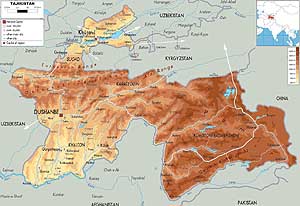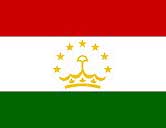-
- Tajikistan Map
|
-
- Map
of Central Asia
|
|
-
|
- latest picture:
June 27, 2016
|
-
-
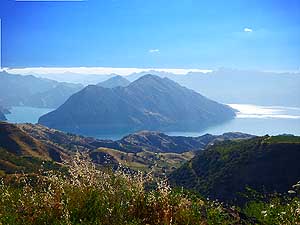
|
-
-
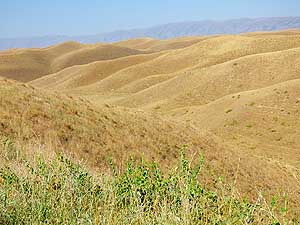
|
-
-
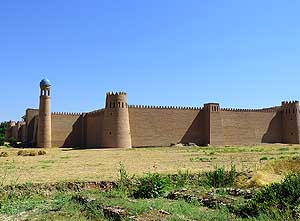
|
-
085 We have breakfast with view to the Nurek
- reservoir, situated about 50 miles [80km] from
- Dushanbe. We are on our ”southern“ way to the
- famous Pamir Highway, i.e. via Kulob because the
- Khaburabot Pass (Sagirdasht Pass) – the M41
- via Tavildara – is said to be in a miserable shape
|
-
086 After Dangara we pass rolling
- heat-baked hills in the ”southern Tajik
- wheatfields“ for some miles
|
-
087 At Kurbon Shaid (Pingan),
about
- 18 miles [30km] before Kulob, lies the
- new looking Hulbuk Fortress Palace –
- a reconstruction from the 11th century
|
-
|
-
-
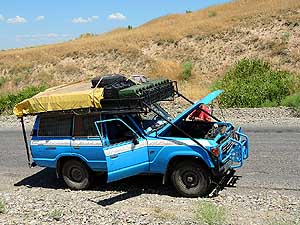
|
-
-
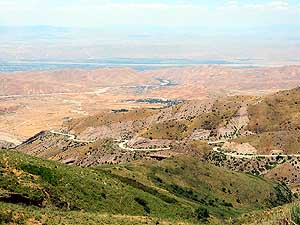
|
-
-

|
-
088 From Kulob the road climbs up to
- Shurabad, a crossover of 6'500 ft. [1’980m]
- to the very long Panj valley. This is where the
- overheating problem of our LandCruiser restarts.
- Emil sucks in fuel, cools the carburetor with water
- and fixes an additional fan next to the carburetor
|
-
089 Sweeping view from the Shurabad
- mountain pass down to the valley
- towards Kulob (green left at the back)
|
-
090 Huge trucks,
generating a lot of dust,
- and locals on donkeys are on the Shurabad
- pass ascent. Many trucks tow
- additionally a huge trailer
|
-
|
-
-
-
-
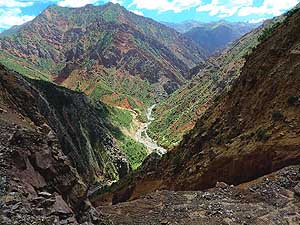
|
-
-
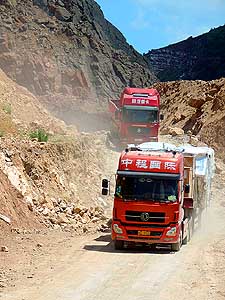
|
-
-
-
-
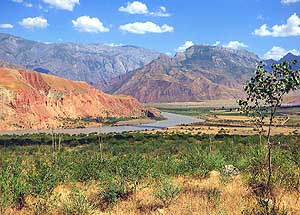
|
-
091
After the Shurabad pass we are
- encircled near Chilishtak by an imposing
- rocky mountain scenery
|
-
092
Chinese trucks, partly with trailers,
- cross us on the dusty road to the Panj river.
- They supply Tajikistan with goods from
- China and are real masters in managing
- the most critical passages
|
-
093
Scenery at the Panj river after descending
- from the height of 6'500 ft. [1’980m] in Shurabad
- to 2'700 ft. [825m]. On the other side of the
- relatively narrow river is Afghanistan. It’s possible
- to drive along the river for about 415 miles
- [670km] (incl. Wakhan area) – in Khorog we
- have seen enough of it after 225 miles [360km]
|
-
|
-
-
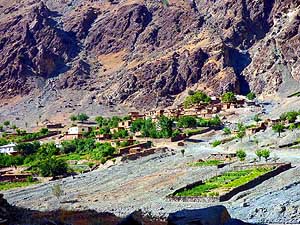
|
-
-
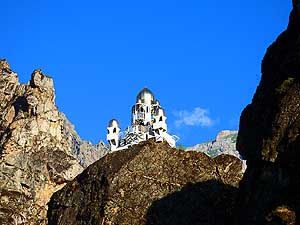
|
-
-

|
-
094 One of the adobe hamlets set among
- patches of greenery on the Afghanistan side
- during our 225 miles [360km] long drive along
- the Panj border river on a mostly dreadful
- track and through deep and narrow gorges
|
-
095 Part of the recreation center “Chorchaman”
- that was erected at the little village of Patkunob
- before Kalaikhum. This is already since 43 miles
- [70km] (and will remain until the Kyrgyzstan
- border) the autonomous province of Gorno
- Badakhshan (GBAO), where a permit is
- compulsory that is available either from the
- consulate together with the visa or otherwise
- from OVIR in Dushanbe (38.57126/68.79722)
|
-
096 The fuel pumps in
Kalaikhum are
- empty or they don’t work. Fuel is sold
- along the road either from tankers,
- jerrycans or barrels. We bunker
- 21 gallons [80 liters] from jerrycans
|
-
|
-
-
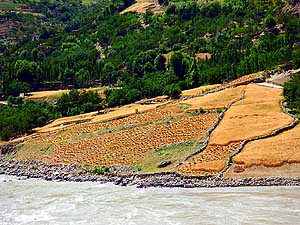
|
-
-
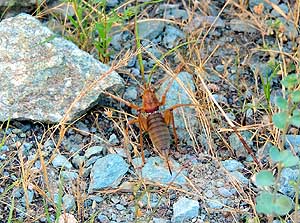
|
-
-
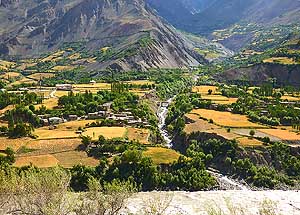
|
-
097 On the Afghanistan side of the Panj
- river grain harvesting is in full swing. The
- yellow grain fields are in sharp contrast to
- the deep green trees surrounding them
|
-
098 On her discovery tour Liliana almost
- steps on this well camouflaged cricket. The long
- spike at the back is for laying eggs (ovipositor)
|
-
099 After the mouth of the
Vanj Valley into the
- Panj River – halfway between Kaleikhum and
- Rushan – golden fields of grain reaching up to the
- slopes dominate the scenery on the Afghan side
|
-
|
-
-
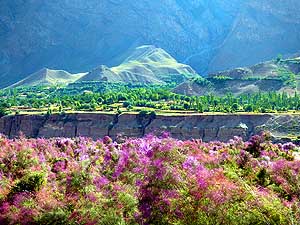
|
-
-
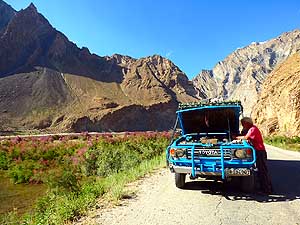
|
-
-
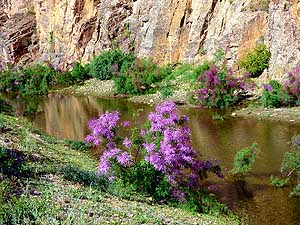
|
-
100 Nature is exploding along the water
- ways. Wherever we look, carpets of pink
- flowering bushes cover the plain …..
|
-
101 ….. on this idyllic spot our Land
- Cruiser gives us trouble once more.
- For the umpteenth time, Emil is cooling
- down the carburetor with water …..
|
-
102 ….. while Liliana
takes the
- opportunity to explore the surroundings
- and enjoy the beauty of nature
|
-
|
-
-
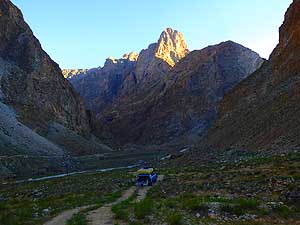
|
-
-
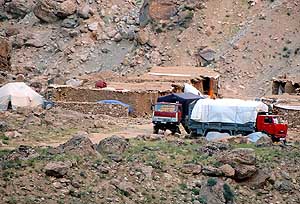
|
-
-
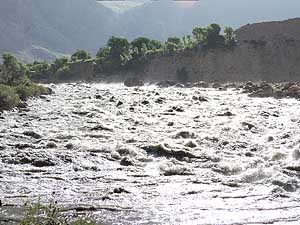
|
-
103 About 9 miles [15km] before Yarkh
- Lake or 27 miles [44km] before the “city” of
- Rushan, the narrow valley opens slightly and
- we find a small and levelled camping spot
- squeezed between high rising mountain cliffs …..
|
-
104 ….. on the other side of the Panj river,
- on the Afghan side, stand two fully loaded
- trucks next to adobe dwellings and a white
- tent. A military camp? This road leads in
- 560 miles [900km] to Kabul
|
-
105 We follow further the
Panj river.
- Due to the snowmelt it became a
- dangerous looking brownish “monster”,
- carrying everything down
|
-
|
-
-
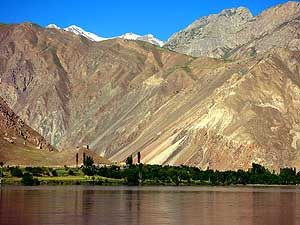
|
-
-
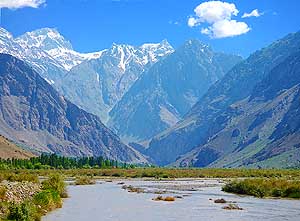
|
-
-
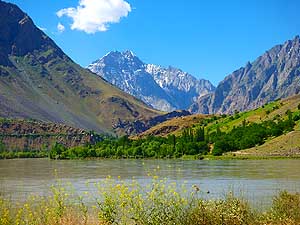
|
-
106 Short of Rushan, the road passes the
- idyllic treelined Yarkh Lake, formed naturally
- by the Panj river – probably the prettiest
- place to live in this otherwise forbidding region
|
-
107 View towards the remote, wild and
- adventurous Bartang Valley, which access
- is shortly after the big settlement of Rushan.
- It’s possible to drive from here by 4x4
- directly to Karakul lake
|
-
108 A landscape that could
be in
- Switzerland – at the continuation
- along the Panj river to Khorog
|
-
|
-
-
-
-
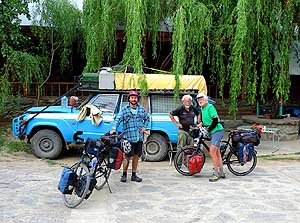
|
-
-
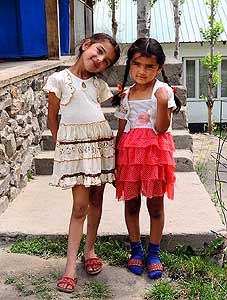
|
-
-
-
-
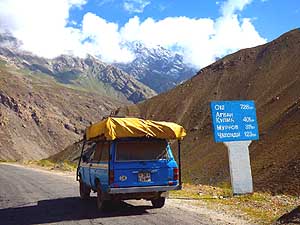
|
-
109 At the Pamir Lodge in Khorog, we
- meet the two cyclists Kaya and Lauro, father
- and son from Switzerland. They are ready
- to take off to the next Pamir Highway section
|
-
110 Two inseparable little friends from
- Khorog. Khorog ist the capital of the
- autonomous province Gorno Badakhshan
- (GBAO) with about 30’000 people (2003)
|
-
111 Road sign to Osh (452
miles)
- [728km] in Kyrgyzstan on the Pamir
- highway. Still a long way to go!
|
-
|
-
-
-
-
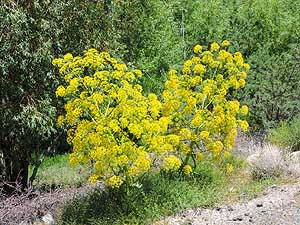
|
-
-
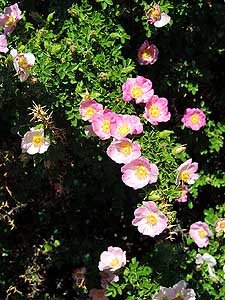
|
-
-
-
-
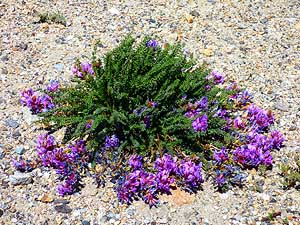
|
-
112
It is impressive how tall flowers
- can grow also in such alpine altitudes
- (above ±10’000 ft.) [±3’000m]
|
-
113
Also delicate bush roses seem
- comfortable on these heights
|
-
114
The pink flowers grow on the ground
- compactly around a garland of leaves
|
-
|
-
-
-
-
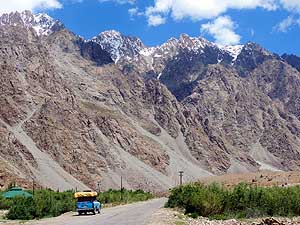
|
-
-
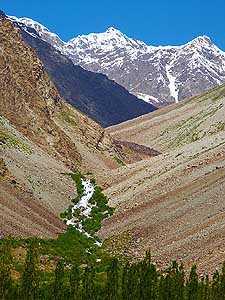
|
-
-
-
-
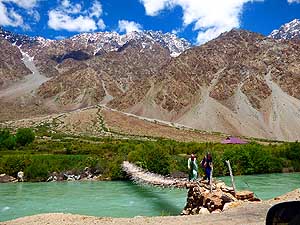
|
-
115
Our LandCruiser climbs along the
- barren high Rushan range to higher altitudes
|
-
116
A glittering mountain torrent makes its
- way downhill, producing greenery on its sides
- – a sight that appears over and over again
|
-
117
A suspension bridge of the old style, built
- only from twigs. Two courageous ladies cross the
- Gunt river to get from their home to the road
|
-
|
-
-
-
-

|
-
-
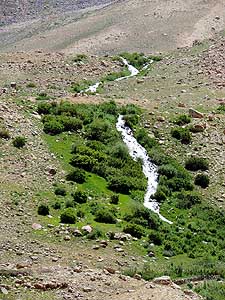
|
-
-
-
-

|
-
118
A timeless sight: Mountain
- scenery near Vankala
|
-
119
Where there is water, there is life. Patches
- of green along a little torrent in a field of scree
|
-
120
The dwelling is pretty modest, but the
- satellite disk on the roof is not missing
|
-
|
-
-
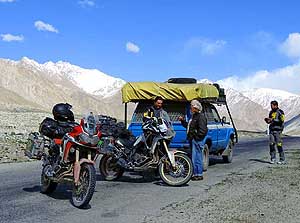
|
-
-
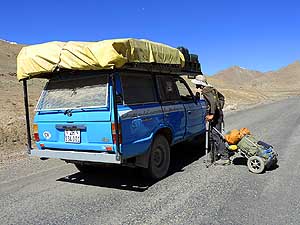
|
-
-
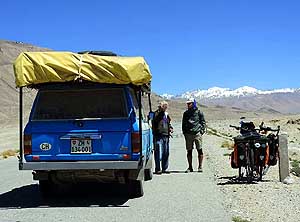
|
- The Pamir region attracts each year cyclists, bikers, car
travelers and hikers – it is still a real challenge.
- Here everyone stops when crossing each other and shares
information. This was still the case between 1989 and 1993 in
Africa
- when we crossed from North to South. Nowadays, this does not
happen anymore, nobody needs obviously the others advice
|
-
121 Two German bikers near Jelandy
- hotsprings. We spend one night together
- at an altitude of 11’800 ft. [3’600m]
|
-
122 A German hiker. He walks
- around 30 miles [50km] daily
|
-
123 Two English cyclists,
who are on their
- way from Osh via Pamir to Dushanbe. They have
- to deal constantly with the strong headwind
|
-
|
-
-
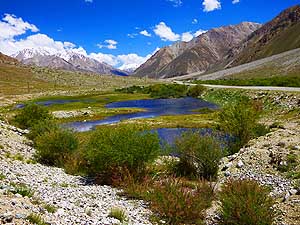
|
-
-

|
-
-
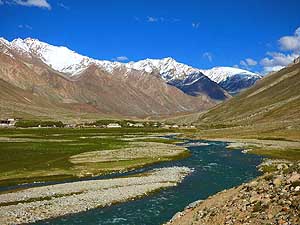
|
-
124 The idyllic alpine pond-dotted scenery
- before the ascent to the Koy-Tezek Pass
- (14’016 ft.) [4’272m] in direction Murgab
|
-
125 A marmot is warming up in the sun.
- It has not yet spotted us!
|
-
126 In a beautiful setting
between a clear
- mountain stream and snow covered peaks:
- The village of Jelandy with its hot springs
|
-
|
-
-
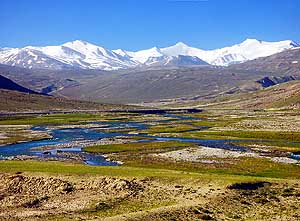
|
-
-
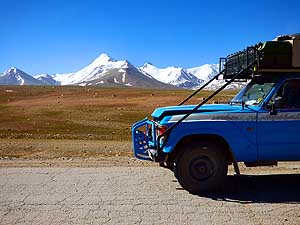
|
-
-
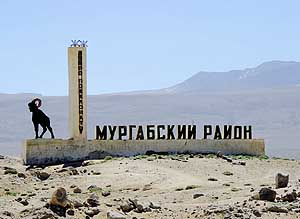
|
-
127 This virgin mountain scenery with its
- wide river valley remembers us of Alaska,
- which we explored in summer 1985
|
-
128 As our LandCruiser steadily gains height
- over the Koy-Tezek-Pass, glacier-wrapped
- mountains appear at every corner
|
-
129 The monument at the
roadside of M41
- – Pamir Highway – says that we are entering
- on the eastern side of the Koy-Tezek Pass
- the district of Murgab
|
-
|
-
-
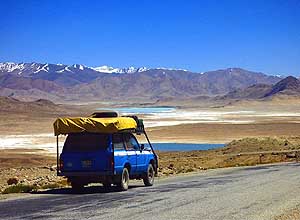
|
-
-
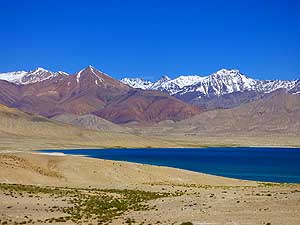
|
-
-
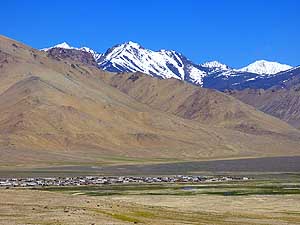
|
-
130
|
-
131
|
-
132
|
- Our LandCruiser is rolling towards the western Pamir high plateau
with its many lakes (Bulun-Kul,
- Yashil-Kul, Sassyk-Kul, Tuz-Kul, etc.), which lies on an altitude
of almost 13’000 ft. [4’000m]
|
- The village of Alichur with its white washed
- flat houses, about 60 miles [100km] before
- Murgab, lies south of the North Alichur Range
|
-
|
-
-
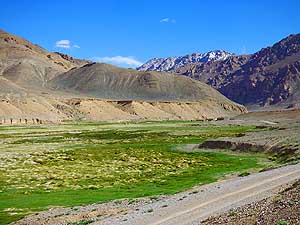
|
-
-
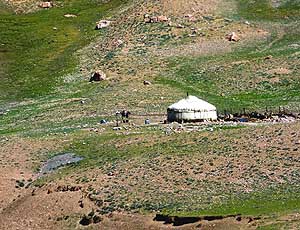
|
-
-
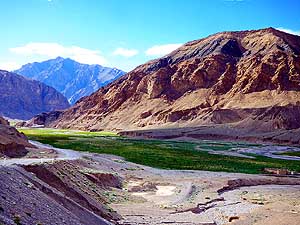
|
-
133 It gets increasingly greener the closer
- we come to Murgab. Halfway between
- Alichur and Murgab, there is the Nayzatash
- Pass to cross: 13’573 ft. [4’137m]
|
-
134 Nomads have put up their yurt
- for the summer months in this isolated
- and harsh environment
|
-
135 Again “greenery”
shortly before
- the final descent to Murgab
|
-
|
-
-
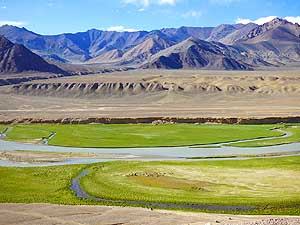
|
-
-
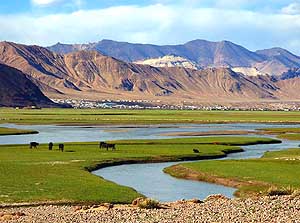
|
-
-
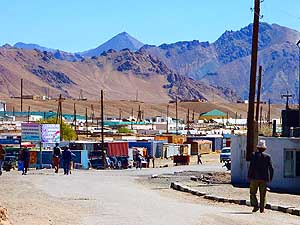
|
-
136 The Murgab valley with its green
- riverside pasture sets off vividly against
- the rugged rock walls
|
-
137 Postcard-perfect: Panoramic view
- across the green Murgab river valley with
- the first houses of Murgab and the bleak
- mountain range in the back
|
-
138 The small town of
Murgab, on an
- altitude of 11’732 ft. [3‘576m] with a
- population of 6‘500, where about 25%
- are Pamiris (Tajiks) and 75% Kyrgyz
|
-
|
-
-
-
-
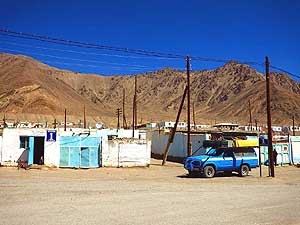
|
-
-
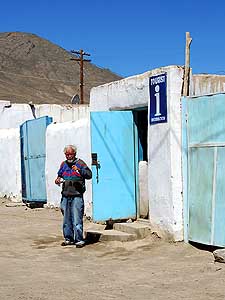
|
-
-
-
-
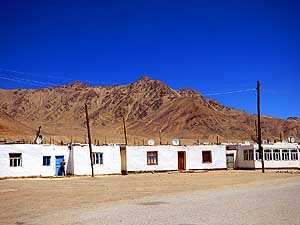
|
-
139
Our LandCruiser in front of the
- nondescript tourist office in Murgab
|
-
140
Emil is waiting outside of Murgab’s
- tourist office for the English speaking lady
- who has been called by phone
|
-
141
Murgab’s white washed “box houses“
- with the background of the bleak mountain
- ridge evoke a bit a feeling of Arabia
|
-
|
-
-

|
-
-
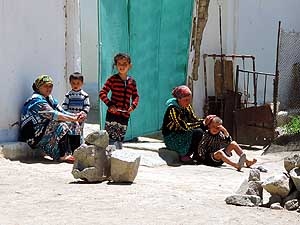
|
-
-
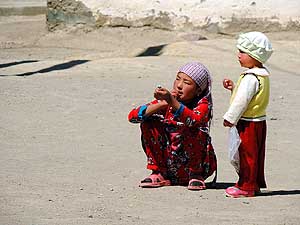
|
-
142 A woman from the mountain village
- of Murgab with her typical head scarf
|
-
143 A family is sitting outside its home
- watching the village live, it is the only pass-time
|
-
144 They pass their time
on the street (what
- they are still able to do!): Children in Murgab
|
-
|
-
-
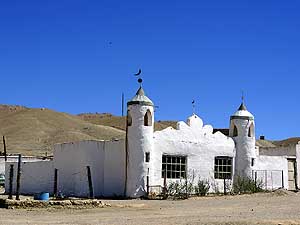
|
-
-
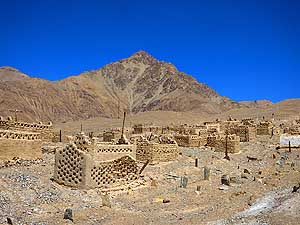
|
-
-
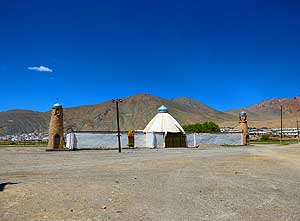
|
-
145 The most appealing village building in
- Murgab is its white washed mosque along
- the Murgab-Tashkurgan road
|
-
146 A cemetery of a special kind: The tombs
- in Murgab are made of adobe – also along the
- Murgab-Tashkurgan road (eastern end of village)
|
-
147 The stone mosque at
the river side
- in Murgab with its two brick minarets
|
-
|
-
-
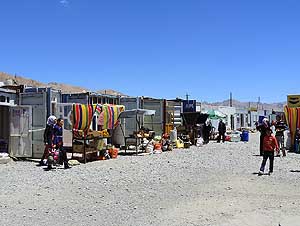
|
-
-
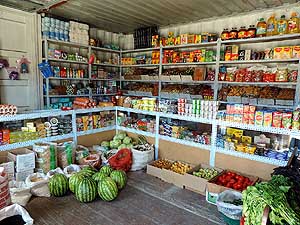
|
-
-
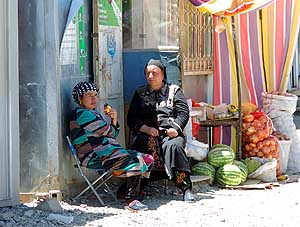
|
-
148 Not a colorful market: The bazaar in
- Murgab consists of a row of unattractive container
|
-
149 Clean, orderly and well-stocked:
- A food container at Murgab‘s bazaar
|
-
150 Two market women
gossiping at the
- Murgab bazaar while waiting for customers
|
-
|
-
-
-
-
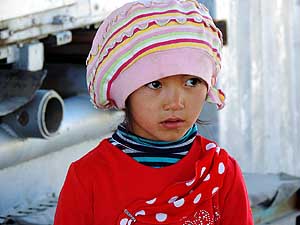
|
-
-

|
-
-
-
-
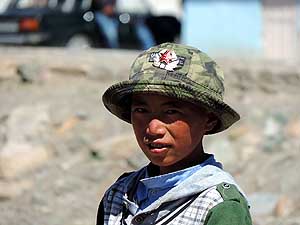
|
- Faces of children in Murgab
|
-
151
|
-
152
|
-
153
|
-
|
-
-

|
-
-
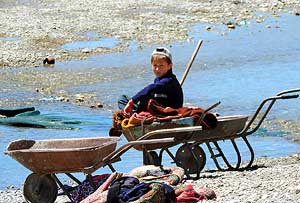
|
-
-
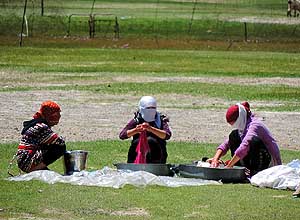
|
-
154 Saturday at the riverside in Murgab:
- Girls are busy scrubbing carpets …..
|
-
155 ….. “Somebody has to supervise
- the ladies!“ says the boy on the pushcart
|
-
156 ….. laundry day: Work
is
- easier in company of friends
|
-
|
-
-
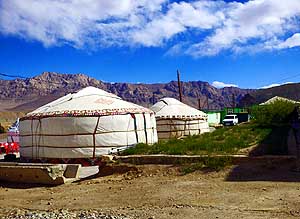
|
-
-
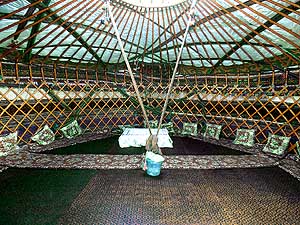
|
-
-
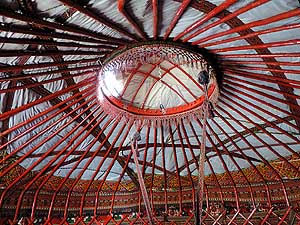
|
-
157 Two traditional guest yurts – dome
- tents used by nomads – in front of the
- Pamir Hotel in Murgab
|
-
158 The appealing interior of a yurt: The
- framework is made from wood, the walls are
- covered with carpets with different motifs, the
- atmosphere is warm and welcoming …..
|
-
159 ….. the roof opening
of a yurt
|
-
|
-
-
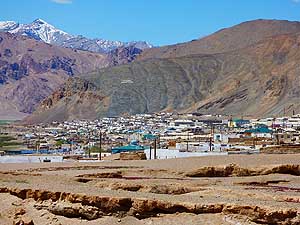
|
-
-
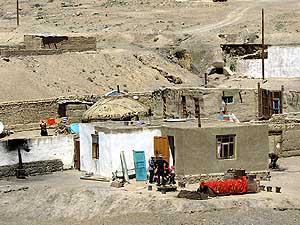
|
-
-
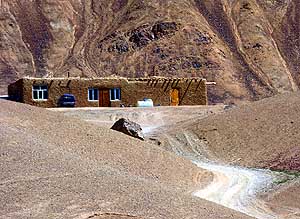
|
-
160 Murgab seen from the river. There is
- no electricity in the village, therefore also any
- fuel pumps. Fuel is traded in barrels, buckets,
- jerrycans and with funnels. Only a few
- have a generator
|
-
161 There is no hectic in Mugab with
- its character of a “pioneer“ village. Daily life
- in the simple houses happens quietly always
- in the same framework
|
-
162 Matching entirely with
nature:
- An adobe house at the foot of the
- mountain range in Murgab
|
-
|
-
-
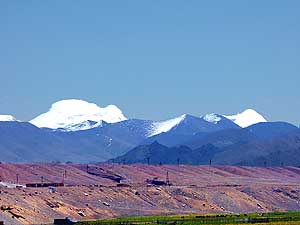
|
-
-
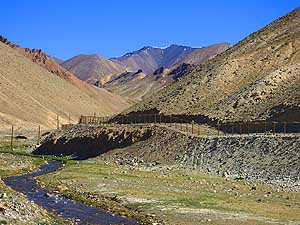
|
-
-
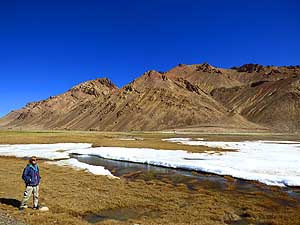
|
-
163 The white mountain peaks that rise
- east of Murgab belong already to China
|
-
164 The fence along the high-altitude
- highway marks the “neutral zone“ to China.
- It was built by China and forms a kind of
- security zone from China. The actual border
- however lies up to 12 miles [20km] more
- to the North resp. to the East of the fence
|
-
165 At the climb to the
- 15’272 ft. [4‘655m] high Ak-Baital
- pass we encounter snow for the first
- time again since Turkey
- (May 30th, 2013). Liliana wants
- once again to know how it feels
|
-
|
-
-
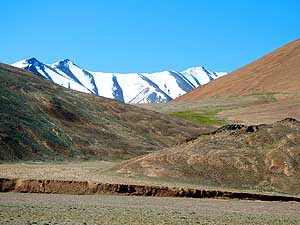
|
-
-
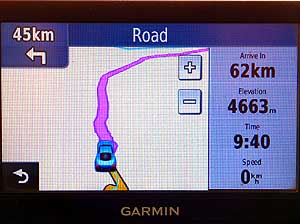
|
-
-
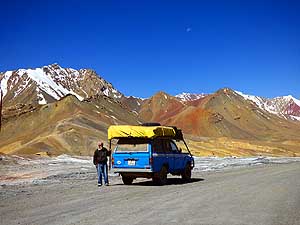
|
-
166 Before reaching Ak-Baital pass
- (= White Horse) on an altitude
- of 15’272 ft. [4‘655m]
|
-
167 We reached the highest drivable
- point of the Pamir Highway: The Ak-Baital
- pass with a height of 15’272 ft. [4‘655m]
- – GPS shows 15’299 ft. [4’663m]
|
-
168 Emil and our
LandCruiser on the
- “Roof of the Tajikistan-World“, on the
- 15’272 ft. [4‘655m] high Ak-Baital pass
|
-
|
-
-
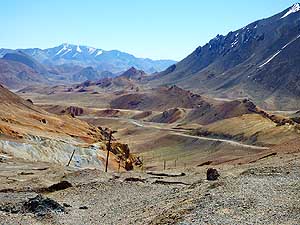
|
-
-
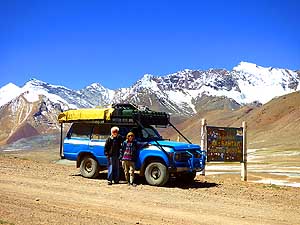
|
-
-
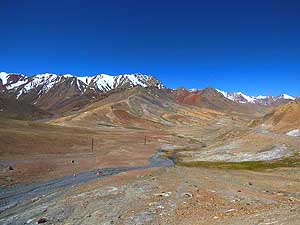
|
-
169 The high mountain region around Ak-Baital
- pass is bleak and entirely uninhabited. Not
a
- single plant is growing; view
in direction Murgab
|
-
170 We seal our achievement of having
- reached the highest point of the Pamirs
- with a remembrance picture
|
-
171 A range of colors in
brown-red pastel
- shades: The high mountain scenery of the
- Pamir Highway towards Lake Karakul
|
-
|
-
-
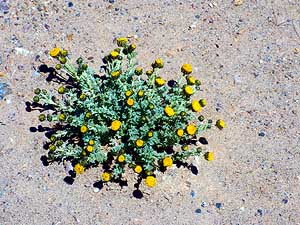
|
-
-
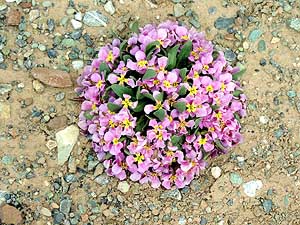
|
-
-
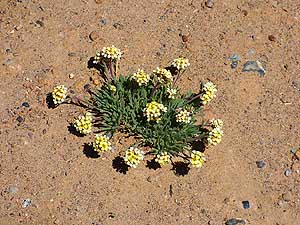
|
- The wonder of nature: Three flowers, which brave the harsh alpine
climate in all its forms, have unfold their full beauty
|
|
172 |
-
173
|
-
174
|
-
|
-
-
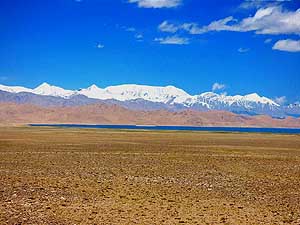
|
-
-
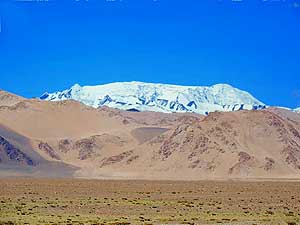
|
-
-
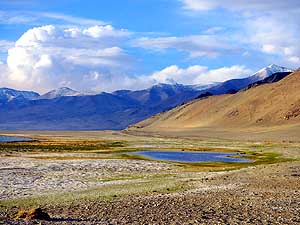
|
-
175 The azure-blue ribbon at the foot
- of the snow-capped mountain chain belongs
- to slightly salty Lake Karakul. It lies at
- 3‘914m altitude and is frozen until May
|
-
176 Glacier wrapped mountains of the
- Tanymas Range west of Lake Karakul
- (altitude 12’841 ft.) [3‘914m]
|
-
177 A little pond on the
eastern
- side of Lake Karakul
|
-
|
-
-
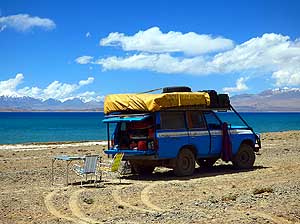
|
-
-
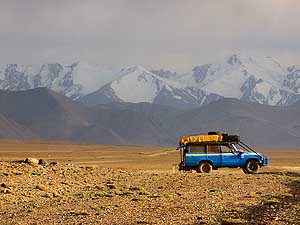
|
-
-
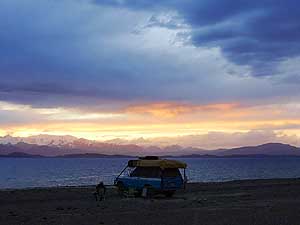
|
-
178 We set up camp in good weather at Lake
- Karakul at an altitude of 12’841 ft. [3‘914m],
- surrounded by the fascinating mountain peaks
- of North and East Pamir …..
|
-
179 ….. in the light of the setting sun
- our LandCruiser is shining beautifully
- against the backdrop of the white
- mountain peaks in the South …..
|
-
180 ….. then the sun sets
and
- simultaneously clouds approach from
- the south. It’s our last night in the
- remoteness of the alpine Pamir region
|
-
|
-
-

|
-
-
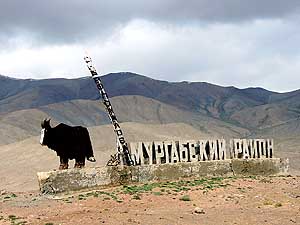
|
-
-
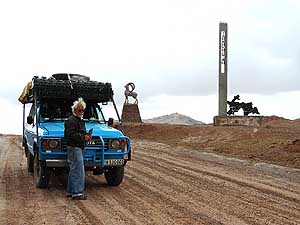
|
-
181 The sky is shrouded in clouds
- when we break off in the morning
- our camp at Lake Karakul
|
-
182 This road monument shows that
- we are now leaving Murgab and hence
- Tajikistan in direction Kyrgyzstan
|
-
183 With a couple of snow
flakes Tajikistan
- waves us good-bye on June 27th, 2016, – a
- country that became one of the highlights of our
- almost 32 years of around the world history
|
-
|
-
Next website of our 2nd
Central and North Asia trip 2016 to Russia:
-
Kyrgyzstan – from
Tajikistan border in Pamir to Kazakhstan
border at Karkara – June 27th to
August 9th, 2016
-
or:
- Back to the 1st part of the Tajikistan trip: Tajikistan Part 1
– May 31st to June 18th, 2016, from
Uzbekistan border to Dushanbe
|
- The African trip
2013-16:
- CapeVerde: Santiago/Praia
part 1 – November18th to December 13th, 2013
- CapeVerde: Fogo
– Dezember13th to 23rd, 2013
- CapeVerde: Brava
– December 23rd to 26th, 2013
- Cape Verde: Santiago/Praia
part 2 – December 26th, 2013 to February 28th, 2014
- Cape Verde: São Nicolau – February
28th to March 13th, 2014
- Cape Verde: São Vicente/Mindelo part 1
– March 13th to 20th, 2014
- Cape
Verde: Santo Antão/Eastern side part 1 –
March 20th to April 7th, 2014
- Cape
Verde: Santo Antão/Western side part 2 –
April 7th to 10th, 2014
- Cape
Verde: São Vicente/Mindelo part 2 –
April 10th to 29th, 2014
-
Namibia Part 1 –
from Walvis Bay to Windhoek
- Angola Part 1
–
September 26th to October 4th, 2014
- Angola Part 2 –
October 4th to 22nd, 2014
-
Namibia Part 2 –
from Windhoek to the Angolan border, back again and on to
South Africa
-
South Africa
Part 1 –
from Namibia border to Capetown –
January 22nd to February 23rd, 2015
- 3rd Major Repair of our
LandCruiser FJ60 - 1982 (due to two broken sideshafts)
-
South Africa Part 2 – from Capetown to Tsitsikamma National Park –
February 24th to March 13th, 2015
- South Africa Part 3 – from
Addo National Park to the Lesotho border – March
13th to April 7th, 2015
-
Lesotho – April 7th to 15th, 2015
-
South Africa Part 4
– from the Lesotho to the Swaziland border –
April 15th to 23rd, 2015
-
Swaziland – April 23rd to 28th,
2015
-
South Africa Part 5
– from the Swaziland to the Botswana border
– April 28th to May 15th, 2015
-
Botswana
-
Zimbabwe
-
Mozambique
-
Malawi
-
Armed Robbery in Malawi on July
31st/August 1st, 2015
-
Tanzania
-
Kenya
-
Ethiopia Part 1 – from Kenya to
Djibouti –
October 25th to November 18th, 2015
-
Djibouti –
October 18th to 27th, 2015
-
Ethiopia Part 2 –
from
Djibouti to
Sudan –
November 27th to December 9th, 2015
- Sudan –
December 9th, 2015 to January 8th, 2016
|
![]()
